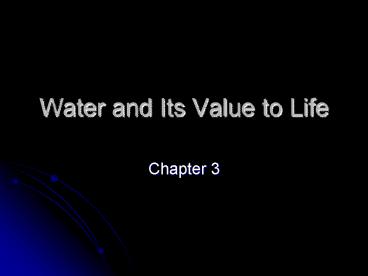Water and Its Value to Life PowerPoint PPT Presentation
1 / 26
Title: Water and Its Value to Life
1
Water and Its Value to Life
- Chapter 3
2
Essential Characteristics of Water
- High surface tension
- --Capillary action
- Resists temperature change
- --High heat of vaporization
- --Low freezing point
- Water expands when it freezes
- Universal solvent
3
Surface Tension of Water
- Force exerted by surface of water on particles
below
4
(No Transcript)
5
(No Transcript)
6
(No Transcript)
7
Capillary Action of Water
- Attributed to polar nature of molecules
8
Capillary Action is Greater with Smaller Diameter
Tube
9
High Heat of Vaporization of Water
- Helps cool animals that sweat
10
or pant
11
Water Resists Temperature Change
- Allows for living things to exist in an
environment where ambient temperature varies
dramatically
12
(No Transcript)
13
(No Transcript)
14
(No Transcript)
15
Temperature Moderation
- High Specific Heat of Water
- Specific Heat amount of heat per unit mass
needed to raise the temperature by one degree
Celsius - The specific heat of water is 1 calorie/gram C
4.186 joule/gram C - This is higher than any other common substance
16
Temperature Moderation, continued
- Waters high Specific Heat
- Due to hydrogen bonding
- Heat is absorbed when hydrogen bonds break and is
released when hydrogen bonds form, - minimizes temperature fluctuations to within
limits that permit life.
17
Temperature Moderation, continued
- Evaporative cooling
- based on waters high heat of vaporization
- Water molecules require high kinetic energy to
break hydrogen bonds - evaporative loss of water molecules cools a
surface.
18
Density of Water
- Ice Floats
- Ice is less dense than liquid water
- Due to hydrogen bond formation
- Causes expansion into crystal formation
- Oceans and lakes dont freeze solid
- Floating ice allows life to exist under the
frozen surfaces of lakes and polar seas.
19
Water Expands When It Freezes
- In liquid water, the molecules move about freely
- In ice, the molecules assume a rigid lattice
structure
20
- Liquid Water
- Ice
21
Water as a Solvent
- Polarity of water
- Water molecules attracted to charged and polar
substances - When ions or polar substances are surrounded by
water molecules, they dissolve and are called
solutes.
22
Water as a Solvent, Continued
- Hydrophilic ? affinity for water.
- Hydrophobic ? repel water (because some things
can and do repel water, it is not truly a
universal solvent). - Water most important solvent for living things
- Water about 70 to 95 of most organisms
23
Acids Bases
- pH measure of how acidic or basic a solution is
- Ranges from 0 to 14
- Acid any substance that forms hydrogen ions
(H) in water (H2O) - pH lt 7
- Base any substance that forms hydroxide ions
(OH-) in water (H2O) - pH gt 7
- Neutral Substance pH 7
24
The Dissociation of Water Molecules
- Organisms are sensitive to changes in pH (pH
-log H) - Water can dissociate into H and OH-
- The concentration of H is expressed as pH,
- Acids donate additional H in aqueous solutions
- Bases donate OH- or accept H.
25
- In a neutral solution, H OH- 10-7, so pH
7. - In an acidic solution, H is greater than
OH-, and the pH is less than 7. - In a basic solution, H is less than OH-, and
the pH is greater than 7. - Buffers in biological fluids resist changes in
pH. A buffer consists of an acid-base pair that
combines reversibly with hydrogen ions.
26
- Acid precipitation is rain, snow, or fog with a
pH below 5.6. - Due to reaction in air between water vapor and
sulfur oxides and nitrogen oxides - One source combustion of fossil fuels.

